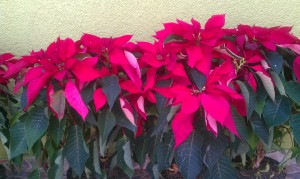 We send beautiful Poinsettia Greetings from the Tropics! This beautiful Central American native plant flourished long before Christianity and Europeans  came to the Western Hemisphere.  One Indigenous group, the Aztecs, found it blooming in the tropical highlands of southern Mexico during the very short days of winter and named it “Cuetlaxochitl.”  The indigenous peoples of the Isthmus did not consider it as a decorative plant seeing it grew to up to 10 feet tall. But many of these groups used it for other practical purposes such as a dye and its sap as a cure for fever. I too have seen it growing upwards of 3-4 meters in height in Northern Thailand.
We send beautiful Poinsettia Greetings from the Tropics! This beautiful Central American native plant flourished long before Christianity and Europeans  came to the Western Hemisphere.  One Indigenous group, the Aztecs, found it blooming in the tropical highlands of southern Mexico during the very short days of winter and named it “Cuetlaxochitl.”  The indigenous peoples of the Isthmus did not consider it as a decorative plant seeing it grew to up to 10 feet tall. But many of these groups used it for other practical purposes such as a dye and its sap as a cure for fever. I too have seen it growing upwards of 3-4 meters in height in Northern Thailand.
This beautiful Poinsettia plant would have remained only a Central American regional plant had not Joel Roberts Poinsett been appointed as the first United States Ambassador to Mexico by then president James Madison back in the 1820’s.Â
Mr. Poinsett was a self taught botanist who obviously loved plants and while on assignment as the Ambassador to Mexico he became enchanted by the beautiful red leaves of the Poinsettia plant. Later on he sent some specimens back to the US and hence we now all can enjoy the beauty of this plant around the Christmas season. The poinsettia plant took on the name of Mr. Poinsett who was the one who first introduced it to English speaking North Americans.  Â
As a missionary in Central America I have often wondered how the Poinsettia plant named so in English became known in Spanish as “Pascua de Navidad†In English the word came from paschal, Hebrew meaning The Passover (hence paschal lamb) or Easter.. Over time in Latin America the word “Pascua†became associated in a general sense with most major Catholic holy days including Easter  and thus the Poinsettia which only turned red at Christmas became known as the Pascua de la Navidad. Hence today we use the word La Pascua de Navidad for this beautiful plant.Â
You can read more of what we do at Christmas and how we are inspired to help those with less opportunity through our Click for St. Nick program on this site.
Feliz Pascua from Central America!
